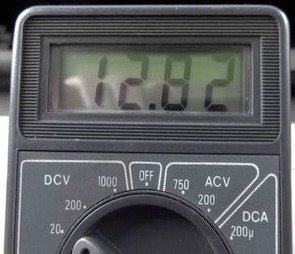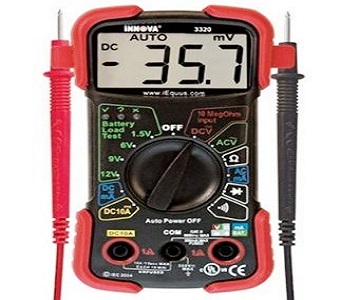
In this easy to follow guide, we’ll talk about how to use a DMM (Digital Multi-Meter). We’ll bring order to the chaos of settings on the face of this handy automotive diagnostic tool.
Once you realize the scales in each zone, simply move the decimal place on the display, you’ll be searching for electrical circuits to test.
We’ll also discuss how an auto ranging meter can simplify diagnosis and why these cost a little more money. Also on the financial side, I’ll review the criteria to help you select the right meter and explain why you don’t need a $500 meter to test voltage.
Automotive Meter Settings
When it comes to using a digital meter for automotive testing, the two most commonly used areas, are the DCV (Direct Current Voltage) and the resistance scale. If you look at the face of the meter, in these two zones you will find a range of settings called scales that will be selected according to what is being measured.
As an example, if you’re testing a wire or a component that should have voltage between one and 5 V, the 200 or twenty scale is most often selected.
When the 200 range is chosen there will be one number to the right of the decimal point. If you choose the twenty scale there will be two number places to the right of the decimal point.
Therefore, we can conclude that the further we move the scale to the left, the smaller amount of voltage we are reading on the display.
The most important lesson here for people to understand is that when you’re changing the settings on a digital meter you are actually moving the decimal point to the left or to the right. This allows the measured voltage too display properly.

Further to the left on the DCV scale would be 200 M. This stands for millivolts on the 200 scale. If you try to measure battery voltage when this is selected the number one or OL (out of limits) will show up.
This indicates the reading is out of range. This is because millivolt is an extremely small amount of voltage compared to battery voltage which is a larger amount.
The milli voltage scale, whether it’s 200 or 2000 is selected for components using small amounts of voltages to communicate to the power train control module (PCM). As an example the knock and wheel speed sensor are two permanent magnet generators that create their own electrical signal. You read these signals on the millivolt scale of an automotive meter.
Auto Ranging Vs. Manual Meters
When you’re using a manually adjusted digital multimeter, to select the proper scale, you need to know the amount of voltage, amperage or Ohms of resistance that normally exists in the circuit being measured.
Example, if you’re testing a throttle position sensor the range of operation is between one and 5 V. In this case you select the 200 or twenty scale. When using an auto ranging meter there’s an on-board processor sensing the type of circuit being tested.
This automatically selects the proper scale for the situation. These kinds of testers can make life a whole lot easier for a do-it-yourself mechanic, because you don’t have worry about finding the perfect setting.
The downside is the processor makes the tool itself a little more expensive. Another downside is, if the meter selects the right scale for you, it takes away the learning process.
People using a manually selected range type unit learn more about electrical diagnosis. Selecting the proper scale for the given circuit demonstrates understanding of the system that’s being tested.
This type of knowledge can be critical in locating intermittent or complex malfunctions. For this reason I recommend that a good manual ranging meter is actually a better selection for both advanced and beginner technicians.
Selecting the Right Meter for You
If you’re just looking for a digital multi meter to perform occasional car repair tests then there’s really no reason to bust the bank on expensive tools.
There are many inexpensive auto-ranging multi-meter choices in the $20-$30 range that will produce quality results when testing a wide range of components.
This is especially true when testing voltage on automotive systems. When testing for Volts the range can be broken down into three major groups.
Most 12V systems will operate the lights and a lot of the accessories like power windows, door locks and lighting systems.
When testing reference voltages that flow out to individual sensors you’ll find readings in the 1 to 5 V range. Testing sensors that produce their own signals will fall on the millivolts scale.
All of these ranges are well represented on even the cheapest meters. The more expensive auto ranging tool might include other functions that home based technicians will use sparingly.
As an example some fancy DMM’s will have the capability of reading temperatures via a probe that plugs into a separate port on the meter.
Another function that’s also included in more expensive tools would be the capability of reading RPMs via some type of inductive pick-up that can be clamped around a spark plug wire. These pick up pulses of current from a radiated magnetic field and return engine revolution data.
Learning Electronics is Logical
In conclusion, purchasing an automotive digital multimeter is a great investment for all levels of mechanics. Spending $300 plus on a full-blown fluke meter might not be right for everybody.
When it comes to using the meters, it’s a situation where practice makes perfect. The more you use it the more you become familiar with the settings and the tools capabilities. The interesting thing about automotive electronics is that the theory and principles are based on logic. This makes learning how to diagnose complex electrical problems within reach of people with logical thought processes.YouFixCars.com contains a lot of auto repair information geared towards those with a do it yourself mentality. For more information about what is included on this website this next link will take you to the home page.

